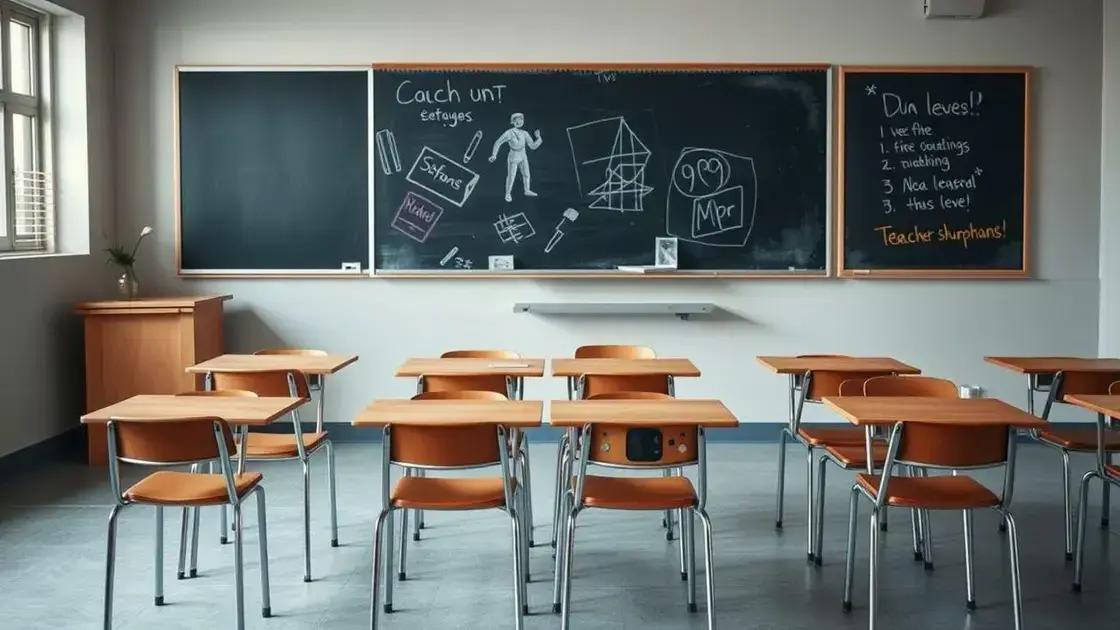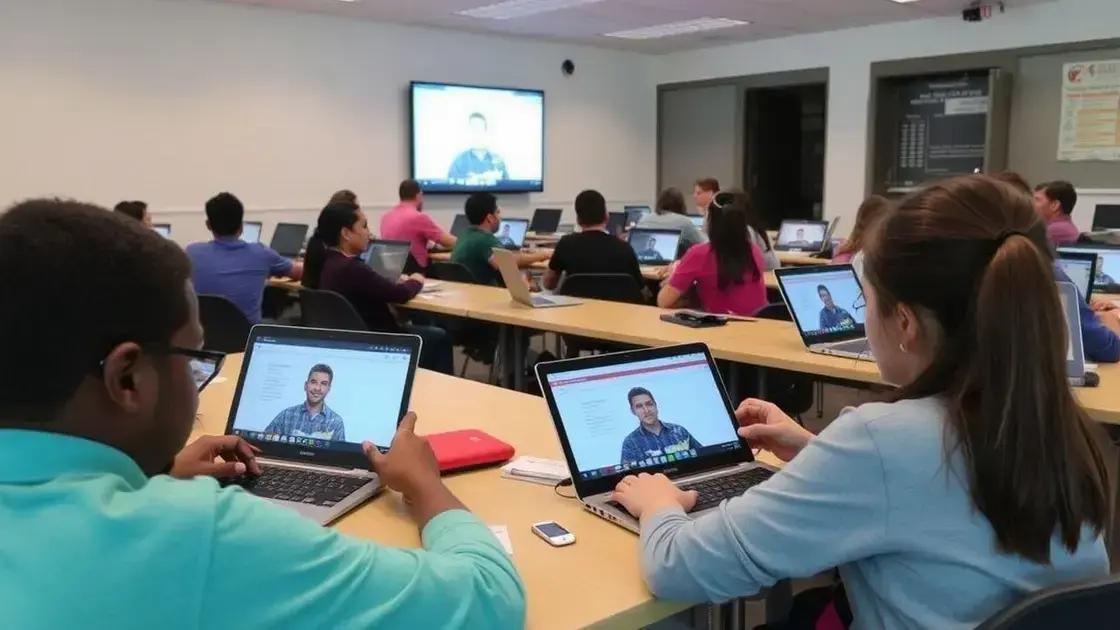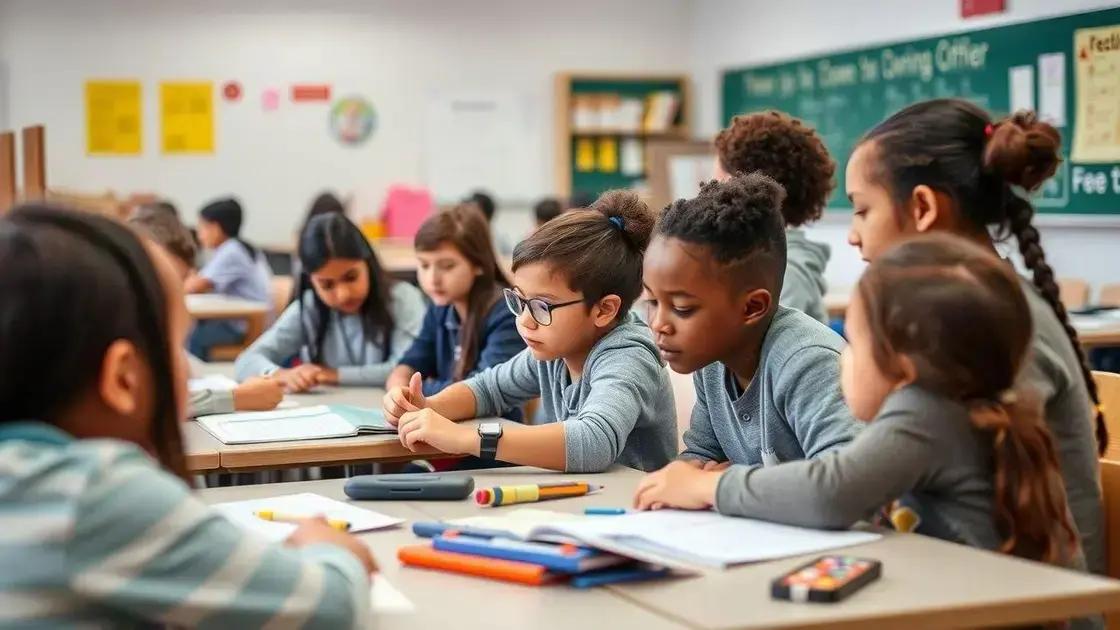Special education programs that make a real difference

Special education programs provide essential, tailored support for students with unique learning needs, addressing challenges while fostering academic growth and social skills through individualized strategies.
Special education programs play a vital role in supporting students with unique needs. Have you ever wondered how these programs work and the positive impacts they bring? Let’s dive into their benefits and what makes them effective.
Understanding special education programs
Understanding special education programs is crucial for parents and educators. These programs offer tailored support to students with unique learning needs. They aim to ensure that every child receives the attention and resources necessary to thrive academically and socially.
What are special education programs?
These programs are designed to meet the diverse needs of students, including those with disabilities. They provide individualized education plans (IEPs) that outline specific goals and support systems.
Key features of effective programs
Effective special education programs share some common features:
- Individual assessments to tailor learning experiences
- Qualified staff trained in specialized teaching strategies
- Collaboration with families to ensure holistic support
- Access to assistive technologies to enhance learning
Each program focuses on empowering students by recognizing their strengths. For instance, some students excel in creative subjects while needing extra help in math. By communicating openly with educators, parents can help ensure that the program addresses their child’s specific needs.
How do these programs support students?
The support in special education programs goes beyond academics. Social skills, emotional development, and life skills are also emphasized. This holistic approach prepares students for real-world situations.
For example, role-playing activities can enhance communication skills, while group projects build teamwork. Additionally, students learn how to advocate for themselves, which is a vital skill.
As we explore the landscape of special education programs, it becomes clear that understanding the available options is key. Parents and teachers both play significant roles in navigating these programs effectively. By working together, they ensure every child receives the individualized support needed to succeed.
Key features of effective programs
Key features of effective special education programs can make a significant difference in a student’s educational experience. It is important to recognize what elements contribute to a successful program that meets the diverse needs of students.
Individualized Education Plans
One fundamental aspect is the Individualized Education Plan (IEP). Each student has unique strengths and challenges. An IEP outlines specific goals tailored to the student’s needs, ensuring the instruction is relevant and effective.
Supportive Environment
Effective programs also create a supportive and inclusive environment. This includes:
- Smaller class sizes for personalized attention
- Access to specialized staff, such as psychologists and speech therapists
- Flexibility in teaching methods to accommodate various learning styles
Collaboration among educators, parents, and specialists leads to a more cohesive support system. When everyone works together, it becomes easier to help students succeed.
Use of Technology
Technology plays a crucial role in enhancing learning for students in special education programs. Tools can include:
- Assistive devices that aid communication
- Interactive software tailored to specific learning goals
- Adaptive tools that facilitate participation in classroom activities
These features allow for interactive learning experiences that can greatly boost engagement and retention.
Additionally, regular assessments and progress monitoring help to ensure that students are on track to meet their goals. By being proactive in adjusting strategies based on student performance, educators can provide the best support possible.
How to choose the right program for your child

Choosing the right special education program for your child is essential for their success. With various options available, it’s important to carefully evaluate what fits best with your child’s unique needs.
Assess Your Child’s Needs
The first step is to assess your child’s specific requirements. Every child learns differently, so understanding their strengths and challenges is key. Consider discussing your child’s needs with educators or specialists.
Research Available Programs
Once you have an idea of their needs, research the programs in your area. Look for schools or organizations that offer special education programs tailored to your child’s needs. Some aspects to consider include:
- The program’s reputation and effectiveness in helping students
- Qualifications and experience of the teaching staff
- Availability of resources and support services
Additionally, reaching out to other parents for recommendations can provide valuable insights. Online reviews and community forums may also give you a clearer picture of your options.
Visit Potential Programs
It’s crucial to visit potential programs to see them in action. Observing classroom dynamics and interactions can highlight how students are supported. Ask questions about:
- How individualized education plans (IEPs) are created and implemented
- How the program encourages social skills and peer interaction
- The methods used to engage and motivate students
By visiting, you can also gauge the atmosphere. A positive environment can make a huge difference for your child’s learning experience.
Finally, trust your instincts. The right program should feel right for both you and your child. Finding a program that aligns with your child’s needs can set the stage for effective learning and personal growth.
Success stories from special education
Success stories from special education programs highlight the impactful ways these programs change lives. Many students who face challenges can overcome obstacles with the right support and resources.
Real-World Examples
A great example is the story of a young boy named Jake. Diagnosed with autism, Jake struggled with social interactions and communication. Through his school’s tailored special education program, he received personalized lessons and social skills training. Now, Jake participates in group activities and has made friendships he once thought impossible.
Transformative Outcomes
Success does not always look the same for every student, but the outcomes can be transformative. Here are a few key results from effective programs:
- Improved academic performance and grades
- Enhanced social interactions and friendships
- Increased confidence and self-esteem
Another inspiring case is that of Emily, who struggled with a learning disability. With the help of a special education program, she learned through hands-on activities and multi-sensory techniques. Today, Emily is excelling in her class and loves learning.
Community Impact
The effects of special education extend beyond individual students. Families often find that support groups and communities come together to create a network of understanding. Parents of children in these programs share experiences, provide encouragement, and celebrate achievements together. Community events often highlight the talents of students, showcasing their growth and successes.
Success stories serve as reminders of the importance of special education programs in helping students realize their full potential. These programs make a difference not only in the classroom but in the lives of students and their families.
Challenges faced in implementing programs
Implementing special education programs can come with various challenges, which can affect the effectiveness of these crucial resources. Understanding these challenges helps schools and families work together to find solutions.
Funding Limitations
One of the biggest hurdles is often funding. Many schools face budget constraints that make it difficult to provide the necessary resources and support staff. This limitation can affect the quality of education provided in special education programs and may lead to larger classroom sizes.
Lack of Trained Staff
A shortage of qualified teachers trained to meet the needs of students in special education can pose a significant challenge. In many districts, there aren’t enough educators who understand how to create effective IEPs. This can leave students without the tailored support they require.
Resistance to Change
Resistance to new methods and practices can also hinder the implementation of effective programs. Some schools may be slow to adopt innovative teaching methods suited for special education. This reluctance can prevent positive change for students who need it most.
Furthermore, communication among staff members, parents, and administration can sometimes break down. When all parties are not aligned, the effectiveness of a program can diminish. This emphasizes the need for open dialogue and collaboration.
Understanding Diverse Needs
Each child has unique challenges that need different strategies. Some programs may struggle to adapt to the varied needs of students with disabilities. This lack of flexibility can lead to ineffective teaching methods that do not foster learning.
Despite these challenges, many schools are actively working to overcome them. By investing in training and embracing new approaches, they aim to enhance the effectiveness of their special education programs. The journey may be complex, but the commitment to better outcomes for students remains strong.
In conclusion, special education programs play a crucial role in the success of students with unique learning needs. Despite the challenges in implementing these programs, such as funding limitations and a lack of trained staff, the positive outcomes they provide are undeniable. Success stories reveal how individualized support can transform lives, fostering academic growth and social skills. Continuous collaboration among educators, families, and communities is vital for overcoming barriers and creating an effective learning environment. By investing in special education, we can ensure every child has the opportunity to thrive.
FAQ – Frequently Asked Questions about Special Education Programs
What are special education programs?
Special education programs provide tailored support for students with unique learning needs, helping them succeed academically and socially.
What challenges do schools face in implementing these programs?
Schools often face funding limitations, a lack of trained staff, and resistance to change, which can hinder the effectiveness of special education.
How can parents support their child in special education?
Parents can work closely with educators, stay involved in their child’s learning, and advocate for the resources their child needs.
What are some success stories from special education programs?
Many students have improved their academic performance and social skills, showcasing how tailored support can lead to transformative outcomes.






